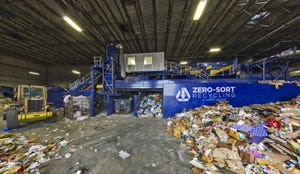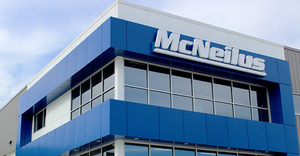High-Tech Upkeep
TIMOTHY MASTROPAOLO, director of purchasing for Cincinnati, Ohio-based Rumpke Consolidated Cos., believes the value of maintenance software to a refuse fleet can be boiled down to a single, simple point: It can help save a lot of money.
Prior to Rumpke's installation of the Transman fleet management system — purchased from Durham, N.C.-based TMT Software — in 1996, the company could recover $100,000 in warranty claims from truck manufacturers for failed parts in a really good year, Mastropaolo says. After bringing in the system, however, that figure shot up to $1.5 million a year, with most of the warranty repair work being done in one of Rumpke's 14 maintenance facilities by its own staff of mechanics instead of at the local dealership.
Then there's managing Rumpke's parts inventory — not an easy task when you need to keep enough parts on hand to support a fleet of 1,400 trucks. “Before 1996, we couldn't even give you a ball park figure for how much our inventory was worth, much less what was in it,” Mastropaolo says.
After they started using the fleet management system and bar codes, however, that changed. “We now know we have $3.5 million in parts to the penny with 98.2 percent accuracy as to the exact kinds of parts we have on hand,” he notes. “We literally went from the Stone Age to ‘Star Trek,’ if you will, in terms of our capabilities with this software.”
But maintenance software offers much more than tracking data on what parts are in stock or what can be recouped through vehicle warranty coverage, fleet experts say. Portland, Ore.-based Pride Disposal uses the same fleet management software as Rumpke, and the system's touchscreen workstations mean increased efficiency for the firm's mechanics, says Booker Nagely, fleet manager for the company. Pride Disposal has eight mechanics spread out in two shops to take care of 80 pieces of equipment.
“With this system, everything is color-coded on a touchscreen, [and] my mechanics aren't stopping their work to type things in on a keyboard,” Nagely says. “We used to spend 30 minutes a day just typing all the work orders into the system. Now we have that time back for working on trucks, to get them back on the road to make money.”
That extra time is what software companies aim to provide.
“The whole paradigm with maintenance software is to increase ‘wrench time’ for maintenance workers by reducing time wasted on manual data entry to track work orders, parts numbers, etc.,” says Ed Cooper, CEO of Seattle-based Squarerigger, a maintenance software provider. “That in turn reduces shop time for truck repairs, making equipment available for revenue-producing work.”
A Tool, Not a Panacea
The key thing refuse fleets must remember about maintenance software, however, is that it's a tool for improving cost controls and strategy and not a substitute for solid fleet management practices, cautions Darry Stuart, president of Wrentham, Mass.-based DWS Fleet Management Services, a firm specializing in fleet maintenance issues.
“Don't get me wrong — almost any fleet needs to have maintenance software,” says Stuart, a veteran fleet manager who spent five out of his 35-year career working for Browning Ferris Industries (BFI) prior to its purchase by Allied Waste Industries in 1999. “But software doesn't replace good maintenance management. It is only a tool to support the maintenance policies in place,” he says.
Stuart explains that software compiles maintenance data to provide a “cost per” metric — the cost per hour or mile or day. That metric can help improve operations. “By itself, software doesn't fix anything,” he says. “For an experienced maintenance director, software provides data to support what you should already know.”
Software also can take “the fleet knowledge out of the head of one individual to all levels of management,” adds Charles Arsenault, founder of Burlington, N.J.-based Arsenault Associates, which developed the Dossier maintenance software package.
“Fleet maintenance software gives a picture of more than just [preventative maintenance] scheduling,” Arsenault explains. “Good software provides the total cost for labor and cost per mile in terms of month, year-to-date, and life-to-date of equipment. It allows re-capitalization of equipment, [and] it also allows [fleet managers] to get into lifecycling to make decisions based on problem equipment rather than just older equipment.”
And it's not just about the shop, as maintenance data can also be inputted directly into a company's accounting software allowing for better data integrity and thus better planning, says D'Alana Loos, finance and information technology manager for Golden, Colo.-based refuse firm EDS.
“That reduces manual re-entry of data and thus the chance of human error so we have ‘cleaner’ numbers to start with,” she says. “We also get more ‘real-time’ figures so we can look at trends for budgeting purposes — how much are we spending on fuel, what trucks are costing us the most to maintain, even what parts we're spending the most money on.”
Yet keeping in mind what maintenance software can and cannot do for your fleet is crucial, says DWS's Stuart. Fleets need the software for three reasons, he says: to manage preventive maintenance schedules, to keep track of parts inventory and to keep tabs on labor costs.
Stuart believes maintenance software will provide the most help to fleets with multiple maintenance locations — allowing them to “see” what's going on in real time at other shops from one location. Yet refuse fleets should also be choosy about the kinds of functions their software will perform, as well.
“Don't put too many demands on it,” Stuart says. “It's like a torque wrench — it's only good if it's used properly. Make sure you get only the software functions you need. Don't buy more features than you need and not use them. That isn't cost effective.”
He also cautions that merely using a software system won't automatically lower maintenance costs. “You need to make better management decisions based on the data it provides.”
Trucks are Computers, Too
Another reason refuse operators are bringing more software into the shop is that the trucks they maintain essentially are computers on wheels, with the ability to “offload” an increasing amount of data about component condition, performance and fuel consumption, among other information, that can be downloaded into a shop system.
“You'd think refuse trucks are simple, but they are one of the most sophisticated pieces of equipment going up and down the road today,” says Pride Disposal's Nagely.
“You have complex electronic circuit boards controlling automated arms and packers that are the same as you'd find on an F-16 fighter plane,” he adds. “We have five computers in the cab alone to control the engine, transmission, hydraulics in the packer body, rear camera systems, etc. Today you need to understand and be able to diagnose electronics like a genius.”
Wayne Wissinger, product manager for Allentown, Pa.-based Mack Trucks, says that all of the firm's refuse trucks include a package of information called “DataMax” in the vehicle's engine control module. A maintenance shop can download the information into its own software system to help maintain its equipment, he adds.
The package of information includes “life of vehicle” (LOV) logs that track a variety of data over the life of the truck, including total operating time, fuel consumption, distance traveled, percentage of time spent idling and spent in the engine's “sweet spot” of optimum fuel economy. Technicians can reset the data that is in the LOV logs. “If a truck is experiencing a problem, the technician can reset the log and view its results after a test drive or the next time the vehicle stops,” Wissinger says.
Service technicians also can program a “fault reporter” into DataMax to log various types of information the next time an engine module fault occurs to reveal the vehicle's speed, engine RPM, pedal and switch positions before and after the fault.
While this data can right now only be downloaded in a shop using special connectors to a technician's computer, Wissinger says that within two years, his firm should be able to offer data uploads in real time through its “Road Connect” telematics system. “It's available on highway and construction vehicles right now and not refuse vehicles yet, but I have received inquiries from refuse companies recently, so availability may be expanded to include them,” he says.
Melissa Gauger, vocational marketing manager of waste vehicles for Warrenville, Ill.-based International Truck & Engine Corp., adds that being able to download information off the vehicle helps refuse fleets analyze component life and spec'ing choices, increase vehicle productivity, and be more proactive on maintenance issues rather than reactive. That was one of the reasons why International developed its “DiamondLogic” electronics system, built into every truck it makes today.
Introduced in 2001, the product is based on a multiplexed electronic wiring system designed to improve data gathering and integration between the truck chassis and body package.
“Remember also that there's a shortage of qualified truck technicians in the market right now,” she says. “So the more information you can get from a vehicle, the more efficiently you can maintain it with the resources at hand.”
“Not only can the fleet's shop download information about the vehicle, they can get the same kinds of information from the packer as well through the DiamondLogic interface,” says Scott Hepler, product manager of builder software for the wiring system. “We're looking to use this technology to get to the point where you can replace a part or component before it breaks down and leads to vehicle downtime.”
Inside-Outside Connection
Finally, there's the ability for shop software to funnel data not only to other systems within the company — accounting and finance being the main links — but also connect with outside systems as well, such as parts vendors.
Morris County, N.J.'s fleet provides one example. Robert Cook, supervisor of the county's motor pool, is using Arsenault Associates' Dossier maintenance program to generate purchase orders for parts.
Cook says that, in the past, his office phoned in all of its orders to parts suppliers. However, when those orders started arriving at the shop, employees spent considerable time distinguishing between parts for specific repairs and those meant for the warehouse shelves. Using the maintenance software now allows him to literally “see” what parts are coming in on a daily basis and what they are for. “Now we can easily match incoming parts with purchase orders, all displayed on our screens,” he says.
Morris County covers 470 square miles 30 miles west of New York City, and the motor pool is responsible for a 1,000-vehicle fleet that includes pickups, heavy-duty trucks (including refuse equipment), lawn mowers and snow blowers.
Some 750 of those vehicles are maintained in a garage in Cedar Knolls, N.J., with seven auto bays, eight truck bays, a body shop, a welding shop, a parts department and a staff of 39 people. Three more work at a small service facility 10 miles to the northwest.
Robert Beckman, assistant supervisor of the county's motor pool, says the maintenance software program helped the county create more detailed and accessible vehicle repair histories, along with a more precise inventory of vehicles, even the 250 or so not maintained at one of the county garages.
The system also allowed Mark Carter, the parts manager, to bring its entire parts inventory back in house. “Now we are able to identify stock parts that are not moving, as some turned out to be seasonal items,” he says. “We were able to implement parts return authorization, and overall we were able to reduce our inventory without disrupting day-to-day operations.”
All in all, vehicle maintenance software can add up to a more organized upkeep of waste vehicles. “Being able to pull together data from a lot of different areas — maintenance cost, parts inventory, technician labor hours — and feed that data into our accounting and finance systems helps us plan for the future better,” says Cindy Leichner, treasurer at Pride Disposal. “We can now see what we're spending on each truck so we can better gauge when to replace them. Our maintenance software not only makes our shop more efficient, it makes the entire company more efficient, as well.”
Sean Kilcarr is senior editor for Waste Age's sister publication, Fleet Owner.
About the Author
You May Also Like


